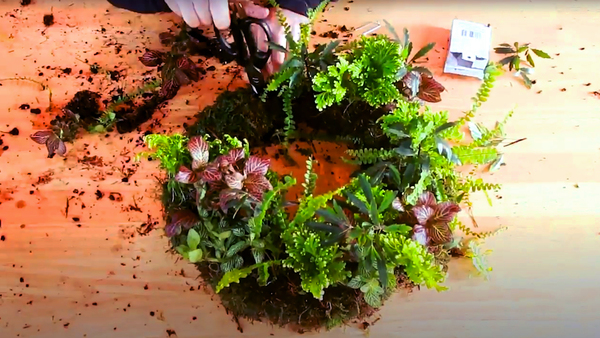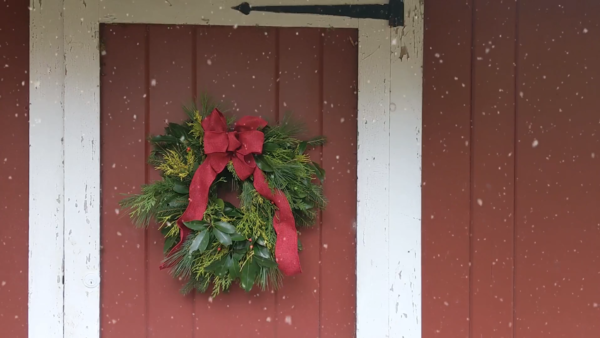
When it comes to crafts, I’m pretty much a lost cause. Maybe that’s a bit overstated. I can knit, sort of—as long as all you want for Christmas is a pot holder, scarf, or simple blanket (which is basically a large pot holder, if you think about it). I don’t scrapbook, I can’t sew, and I don’t even know what decoupage is. The one exception for me is wreath-making. Perhaps I honed my skills because I hate seeing the treasures of the late-fall/early-winter garden go to waste. For me, creating wreaths out of brightly colored branches, unique seed heads, or blushing blossoms is a way of preserving all the hard work I put into caring for the garden throughout the year. And there’s nothing better than looking at a wreath of everlastings in mid-February to remind me that not everything outside is always so bleak.
My favorite type of late-season wreath to make uses panicle hydrangeas as the base. These wreaths are quick, easy, and cheap to make—as long as you wait until the blossoms have turned pink and dried slightly on the bush before harvesting. Follow the next few steps, and you, too, can create a seasonal garden art piece that is way more impressive than a giant pot holder.

Drying hydrangea
We used: ‘Limelight’ panicle hydrangea
(Hydrangea paniculata ‘Limelight’, USDA Hardiness Zones 3–9)

Colorful berries
We used: ‘Sun King’ aralia
(Aralia cordata ‘Sun King’, Zones 4–8)

We used: ‘Elstead’ St. John’s wort
(Hypericum × inodorum ‘Elstead’, Zones 6–9)

Airy grass plumes
We used: ‘Heavy Metal’ switchgrass
(Panicum virgatum ‘Heavy Metal’, Zones 4–9)

Dark-colored seed heads
We used: ‘Goldsturm’ black-eyed Susan
(Rudbeckia fulgida var. sullivantii ‘Goldsturm’, Zones 3–9)

Bright-colored branches
We used: Redtwig dogwood
(Cornus alba ‘Sibirica’, Zones 2–8)
Ingredients from the garden
20 panicle hydrangea blossoms
1 small bunch of bright branches
3 to 4 sprigs of one type of colorful berries
6 plumes of ornamental grass
10 to 12 small seed heads
2 to 3 branches of another type of colorful berries
Materials from the craft store
1 straw wreath base (12-inch diameter)
Metal U-pins
2-inch floral picks
Steps 1 and 2

Remove all of the plastic wrapping from the straw wreath base. Trim off stray pieces of straw hanging from the frame, if necessary.
Gather a small bunch of wreath-making materials. Each bunch should consist of two or three hydrangea blossoms, a couple of 8-inch-long sections of redtwig dogwood, one or two black-eyed Susan seed heads, a small cluster of aralia berries, and one switchgrass plume. Pin the bunch securely to the wreath frame using as many U-pins as necessary (generally three to four).
Steps 3 and 4

Keep adding bunches to the straw frame and pinning them into place so that each new bundle covers the exposed stems of the previous one.
When it’s time to add the final bundle, tuck the stems underneath the hydrangea blossoms of the first bunch. Finish the wreath by wiring small clusters of St. John’s wort berries to the floral picks and sticking them randomly around the wreath. Hang the wreath in a cool dry place, and the materials will dry completely in about one week.
Need more wreath-making inspiration?

Found on Instagram: @jacquelinebdesigns
If hydrangeas aren’t your thing, designer Jacqueline Berg’s Instagram feed is filled with beautiful images of wreaths made from an array of garden everlastings. Inspired by her surroundings in Absarokee, Montana, she harvests and dries ornamental grasses, various herbs, and an array of western hardy flowers for use in her designs.
An avid gardener from a young age, Jacqueline has been creating beautiful wreaths and arrangements for more than 20 years. Get even more wreath inspiration and instruction at Facebook.com/Jacquelinebdesigns.com.
The Best Everlasting Hydrangeas
When it comes to drying hydrangeas, not all varieties are created equal. In general, most panicle hydrangeas dry beautifully, and a select few bigleaf types preserve well too. Here are my picks for holding the best color and shape.

1. ‘Big Ben’ panicle hydrangea
(H. paniculata ‘Big Ben’, Zones 3–8)
Of all the panicle types, these blooms dry the most intense shade of fuchsia. Their large size makes it easy to create an entire wreath using just 12 or so blossoms.

2. ‘Limelight’ panicle hydrangea
(H. paniculata ‘Limelight’, Zones 3–8)
Large, dense flowers dry a light green blushed with pink for a unique color combination.

3. ‘Preziosa’ mountain hydrangea
(H. serrata ‘Preziosa’, Zones 6–9)
The mopheads on this small-blossomed variety flush a brilliant burgundy with dark red speckling in early to late fall. For the best preservation, wait until the flowers are crunchy on the shrub before cutting them off.

4. ‘Ruby Slippers’ oakleaf hydrangea
(H. quercifolia ‘Ruby Slippers’, Zones 5–9)
This is one of the few oakleaf types that has a dense enough flower to dry well. Each flower flushes a brilliant dark pink in early fall. The conical shape of oakleaf blooms gives the wreath a looser look than other varieties.

5. Quick Fire™ panicle hydrangea
(H. paniculata ‘Bulk’, Zones 3–8)
These flowers change to pink early in the season, meaning they can be harvested in midsummer for wreath-making. The red stems can be used in place of redtwig dogwood branches as well.

6. ‘Lady in Red’ bigleaf hydrangea
(H. macrophylla ‘Lady in Red’, Zones 2–9)
Although the blooms are not big and blousy like most bigleaf hydrangeas, this variety sports deep maroon coloring in the fall and holds that hue when dried.
Danielle Sherry is the senior editor.
Photos, except where noted: Danielle Sherry


















Comments
Log in or create an account to post a comment.
Sign up Log in